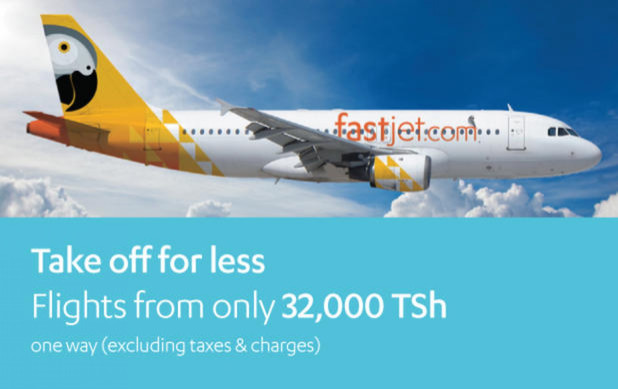Can Fastjet Transform African Air Travel?

When the first Fastjet flight took off Thursday from its base in Dar es Salaam, Tanzania, it ushered in a new age of budget travel for Sub-Saharan Africa.
The carrier is backed by EasyJet founder Stelios Haji-Ioannou, and his ambitions are grand: He hopes to create the first pan-African budget airline. This means an operation with a pay-as-you travel model that is more familiar with Europeans and global standards of safety, quality, security and reliability -- something noticeably absent on a continent whose accident rate is nine times worse than the global average.
Fastjet will start operations in East Africa with its first hub in Dar es Salaam. Another hub is planned for Nairobi, Kenya, as the airline rapidly expands to Uganda, South Sudan and Ethiopia using 15 Airbus A319s by the end of 2013. Fastjet expects it will carry around 750,000 passengers in its first year.
Africa’s more than 1 billion residents are hampered by poor infrastructure and a lack of roads and railways, making traveling between urban centers long and cumbersome. Moreover, Fastjet Chief Executive Ed Winter believes the African aviation market is significantly underserved, particularly with the continent’s rapid economic growth and growing middle class.
“GDP growth is fuelling a real increase in disposable incomes and consumer spending, and although this is accompanied with a growing demand for travel, the African people just haven’t had a reliable and affordable air travel option available to them,” Winter said at an event in Dar es Salaam Tuesday to unveil the first fully branded aircraft. “Fastjet will now serve to fill that gap, and we look forward to bringing the people of Tanzania and indeed the whole continent the first pan-African low cost, point-to-point, all jet airline, operating on international standards of safety and quality.”
According to Airbus forecasts, total passenger traffic in Africa is expected to grow at an average annual rate of 5.7 percent through 2030, well above the global average of 4.8 percent. A separate report from McKinsey forecast that 128 million households in Africa are expected to have discretionary income by 2020. If Fastjet’s sales are any indication, demand is high. In two weeks, the new carrier claims it’s sold about 8,000 tickets, or enough to fill 60 A319s.
However, if Fastjet believes it is positioning itself in a market that is ready to explode, it’s not the first to attempt to “fill that gap.”
“In theory it could be a fast growing and lucrative market, but it hasn’t worked out for a number of prior operators,” said Bob Mann, an airline industry analyst with the New York-based R.W. Mann & Co.
Mann points to Virgin Nigeria as an example of a well-intentioned plan that didn’t pan out. “They found it very difficult trading in Africa. Some of it was the structure of the business, but another part was the inefficiencies involved.”
Currently, air fares in Africa are among the most expensive in the world. The lowest one-way trip from Dar es Salaam to Kilimanjaro on Kenya Airways, for example, is listed at about $340. On Fastjet, it will cost just $27 (though the carrier has indicated such prices will rise to around $80 after the introductory period is complete). Many regular African travelers used to the continent’s flag-carrying airlines may, however, find the experience on Fastjet surprising, as it offers limited legroom and additional charges for everything from luggage to drinks and snacks.
Though two low-cost carriers run domestic flights in South Africa, all other airlines in Sub-Saharan Africa operate full-service flights.
Beyond the domestic market, Fastjet could also enable foreign tourists to hop around Africa, visiting several cities or countries in one trip. This is virtually impossible currently due to poor roads and hefty airfares. In fact, to catch a flight between two African capitals, many must first transfer in Europe.
“These historical -- in some cases colonial -- routes are clearly frustrating for economic development within Africa,” Mann said. “If you’re treating an airline as a public utility, you could say if there’s a lower price point you create a larger market and create more trade. But this is the issue many struggle with.”
Mann said the success level for airline start-ups in the U.S. is around 10 percent and can be even lower in developing regions. So, while the prospect of a low-cost carrier in Africa is exciting for many, Fastjet is flying into uncharted territory and will likely encounter its fair share of turbulence along the way.
“If you look at the examples of low-cost carriers in fairly developed markets, what you find is that they discipline pricing and force the incumbents to be far more efficient,” Mann noted. “Competition is a good thing. Unfortunately, not all competitors survive. Some of the fares are also so uneconomical that it consumes value. We love a free market, but sometimes it’s so irrational that it hurts overall.”
Further complicating matters, government regulations in Africa can be incredibly complex, as can persuading countries in the region to lower their exorbitant departure and airport fees. If Fastjet fails to push for such changes, budget travel will not be a viable option.
The low-cost model Easyjet pioneered certainly rocked Europe’s traditional airline industry. Will it do the same in Africa?
© Copyright IBTimes 2024. All rights reserved.






















